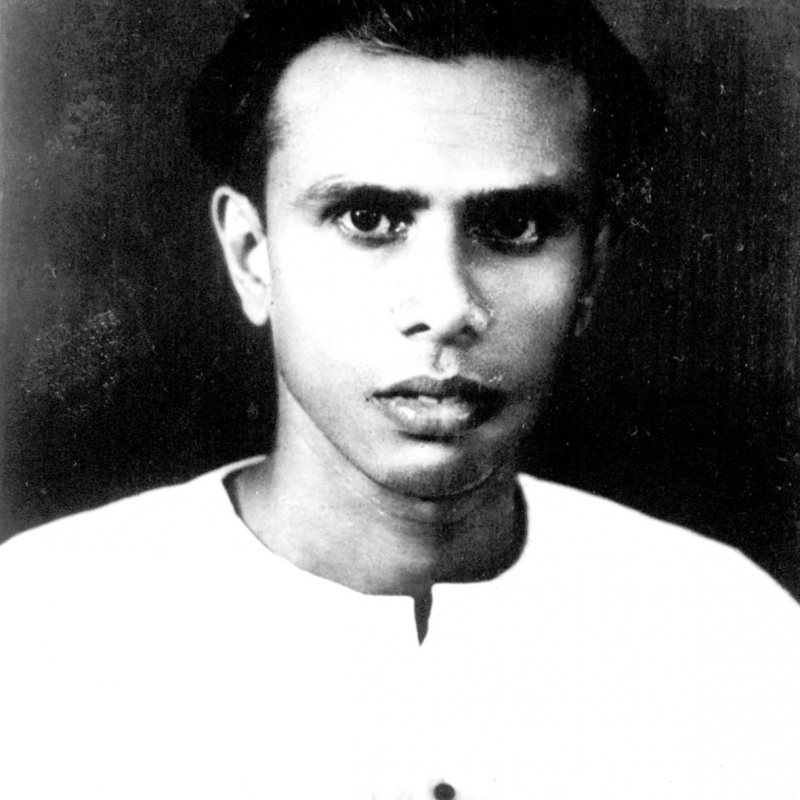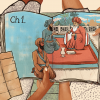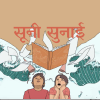This essay[1] intends to look at Pudumaippithan’s non-fictional works and how he engaged with other forms of writing apart from being a popular short story writer. His non-fictional writings such as essays, reviews, political biographies and commentaries present a context to understand Pudumaippithan as a writer and the times he lived in. This write-up will be covering non-fictional works of Pudumaippithan besides giving a small introduction to his complete oeuvre.
Pudumaippithan (1906–48) was a pioneer of modern prose in Tamil. He wrote short stories, essays, book reviews, monographs of political leaders of his time (Mussolini, Hitler, Stalin), poems, letters and an unfinished novel. His works have been collected and published posthumously. But there were disputes among scholars about the authenticity of these anthologies as Pudumaippithan wrote in many newspapers and magazines. The need for a critical edition to Pudumaippithan’s writings has been fulfilled by historian A.R. Venkatachalapathy. Commenting on Pudumaippithan’s writing style, Venkatachalapathy writes:
…In theme, context, language and style, Pudumaippithan fashioned a new sensibility that was self-consciously modern. With sharp wit, sarcasm and irony, he punctured romanticist and idealist dreams—something that is striking given the fact that he wrote at a time when nationalist and social emancipatory movements were riding a crest of popular support. Criticism of the existing reality, but always coupled with self-doubt and irreverence, marks Pudumaippithan’s writings. (2006:74)
Now, let us have a look at Pudumaippithan’s non-fictional writings.
Background
In order to understand Pudumaippithan’s non-fictional writings, it is important to refer to his socio-political background. Working as a sub-editor for newspapers and magazines such as Ooliyan and Dinamani, his writing career was devoted to literary and critical pursuits. However, the increasing demands of his duty as the sub-editor for Dinamani caused a sharp decline in his literary output. Apart from essays, the book reviews that Pudumaippithan wrote in Dinamani need to be understood against this background.
Essays of Pudumaippithan
His essays concentrate on various literary issues and many characteristics, such as styles, forms and genres, of the Tamil literature of his times. He wrote about 50 essays and those can be classified into four broad areas:
1. Ancient Tamil literature and the craftsmanship of poets
2. Discussion on literary genres in Tamil
3. Views on differences between translation and adaptation
4. Essays on Bharathiyar, Bharathidasan and other writers
Ancient and medieval Tamil literary texts came into print and were widely circulated during the first part of the 20th century (Venkatachalapathy 2012a:109; Blackburn 2006). It was also the time when these texts found a place in academia. Pudumaippithan read these texts extensively and commented on them. This includes poems from Sangam Literature, Kambaramayanam, devotional songs of Manikkavasagar (also Manikkavacakar), Thayumanavar and some individual lyric collections. Apart from this, his love for songs and narratives are evident in two of his essays on the subject, ‘Folk Songs’ and ‘Village Life in Tamil Culture’. These essays were able to bring some sense of a critical approach in literary appreciation.
Being a popular story writer, he also initiated discussions on the advent of modern literary genres such as the novel, short story, plays and new verse and wrote essays on the difference between the novel and short story. In the essay ‘Sub-divisions of Literature or Literary Genres’, written by him as early as 1934, he noted that the novel as a genre presented different aspects of life and the world, while the short story offered a singular perspective. His other two essays ‘Stories’ (1934) and ‘Short Story’ (1935) were on the same subject, wherein he mentioned the difference between the generic qualities of short stories and novels, and how both treat narrative materials differently. In these essays, Pudumaippithan discussed the changes that were to be marked with respect to the genre of the short story in 20th-century Tamil literature, wherein due opportunity was given for its proliferation by the printing of journals and periodicals. This enabled the publication of prose writings in Tamil literature.
Pudumaippithan’s translations offer a perspective on the polemics behind translating Western writers. He spoke at length about the contentious nature of translation, and how many writers used it as a method of plagiarising material from other writers. This was specifically mentioned about those writers who wished to bring in stories from other lands, and would fall into the trap of translation, recreation and adaptation. Pudumaippithan’s views may be succinctly understood by the following definition he gives of translation and adaptation:
Translation: To translate a story means that to the best of our ability, to the very extent that the flexibility of our language allows, we present to our readers the product of a foreign culture without jeopardising its essence. Adapation: This is to take the chief events of a narrative from a foreign land, and to elaborate upon them, more or less in the same way as the original, without there being any necessity to retain all its literary aspects. (Translation or Adaptation, Katha Books 2002)
Pudumaippithan mentioned that Western authors who chose to adapt stories, like Shakespeare adapting the tale of Hamlet, did so by taking the frame narrative (the story of a king) and replacing its alien cultural setup with his own environment. He disregards writers whose adaptations are mere copies of other stories, which they parade as their own.[2]
Though Pudumaippithan did not write poems as much as he wrote prose, he admired two poets of his time. Subramania Bharati (1882–1921), a dynamic poet who wrote on progressive ideas and translated stories by Tagore and sections of the Gita into Tamil. Though Pudumaippithan did not accept Bharati’s romantic ideas of life, he wrote essays on Bharati’s poetic ability. He also admired Bharathidasan (1891–1964), whose skills in blending progressive ideas with lyricism is discussed in an essay, Bharatidhasan (1944) where he presents a comparative study of Bharati and Bharatidasan.
Book Reviews
Pudumaippithan wrote nearly 60 book reviews in 1935. These reviews were published in Manikodi and the daily Dinamani. His reviews concentrate on literary works, short monographs, translations, magazines and other published materials. Pudumaippithan was critical about the reviews published by his contemporaries as it misinformed readers:
Now only the habit of buying books and reading them is increasing a little by little. At this point, the sub-standard reviews create false or fake opinions. Not only that. False review is a sharp double-sided knife. These kinds of reviews put the readers into forever foolishness and give a fake self-confidence to the writer at the same time. (Venkatachalapathy 2012:21–22)
Pudumaippithan’s reviews paint a picture of emerging trends of the Tamil book publishing world. The 1930s to ‘50s were an important period for literary activities in India, as the independence struggle led to the formation of many writers’ associations across the country who pledged themselves to socialist values and independence. Pudumaippithan himself having translated quite a few works from English, found the period favourable for bringing the Tamil readership up to date with a few notable titles. He wrote reviews of translations of Charles Dickens’s A Tale of Two Cities (Theyintha Kanavu, 1937) and Molière’s plays like Misanthrope. His translations include Guy de Maupassant’s short stories, Leo Tolstoy’s Anna Karenina, Alexander Kuprin’s works (Pali Pittam), short stories by Sinclair Lewis (Asiriyir Aarayacchi), stories by Moshe Smilansky, Mikhail Sholokhov, Mary Shelley (Frankenstein) and Rabindranath Tagore (Tagore Stories, 1936). Commenting on a Tamil translation of Molière’s play Misanthrope, he mocks the translator’s efforts of word-by-word literal translation and the act of replacing the original names of the characters with Tamil names as it does not reflect as a true translation. A similar criticism was aimed at writers translating from Tamil to English, wherein he cited the case of Neethi Noolkal Paththu (‘Ten Didactic Texts’). Here the translator had taken 10 Tamil didactic texts and translated them, but failed to convey the essence of the texts into English, despite being a Tamil and English teacher by profession. Albeit critical of most translators, he appreciated the efforts of a few chosen writers who did justice to the original and the translated text. He approved of the translation of Charles Dickens’s A Tale of Two Cities into Tamil by Ki. Rajanarayanan as the translator successfully transfers the elegance and lucidity of Dickens’s prose into Tamil. He recommended this translation to his readers and dismissed claims that Tamil readers do not like foreign literature in translation. He also wrote a detailed review of C. Rajagopalachari’s translation of Tirukkural (the section on wealth) into English.
Pudumaippithan did not miss noting important literary works of his time such as Kamalambal Charithram, a novel by B. R. Rajam Iyer, short stories by Rajaji, the novel Kātalā? Kaṭamaiyā? (1938) by Siddi Junaitha Begum, the first Muslim woman writer in Tamil, and other works. He also reviewed books on cinema (Silver Screen, the Telugu film Maya Bazaar), biographies of political and spiritual leaders (Jawaharlal Nehru, Rajendra Prasad and Ramana Maharishi) and on widow remarriage. His sharp reviews and interventions earned him more enemies than friends. T.M.C. Raghunathan observes this while writing Pudumaippithan’s biography:
...When Pudumaippithan was alive, he had more enemies than friends in the literary circles. Pudumaippithan’s short stories were not the reason behind the hostility but his opinions, the reviews that he wrote and the criticism on others works. (Cited in A.R. Venkatachalapathy 2012a:22)
Known as a popular critic, Pudumaippithan said that critics should deal with books like a surgeon by character and his reviews had that quality.
Political Biographies
Pudumaippithan’s political biographies and commentaries present the effect of the political atmosphere of his time, and how they affected his thought and writings. As a writer he was intrinsically a keen observer of both Indian and world politics which led him to write four monographs on famous political leaders of his time. These include political biographies of Adolf Hitler and Benito Mussolini and a book on the role Stalin played in the establishment of Soviet Russia.
These books also submit his stand as an anti-capitalist and anti-fascist and express his sympathy towards the ideas of individual freedom, democracy and socialism. This particular quality of commenting on politics is not found in his contemporaries, thus distinguishing him as a politically aware writer.
The monograph on Mussolini (1938) discusses the history of Italy and Europe through his life events. In this book, Pudumaippithan argues that fascism is the cruel reality of capitalism and the working principle of fascism is and will be against the interests of socialism. He also notes how both Hitler and Mussolini massacred communists without any mercy. Pudumaippithan had a clear understanding that fascism and communism are the two opposite products of industrial age (M.A. Nuhman). His separate monograph on Hitler, co-authored with Ramaratnam, called Hushed Court: Life and Dreams of Hitler (1939), documented the atrocities committed by Hitler and expressed Pudumaippithan’s solidarity with human values.
The book on Stalin (Stalin Knows, 1943?) elaborately discusses the role played by Stalin in establishing a socialist government under his able leadership. Though Pudumaippithan sarcastically criticizes communism in his writings and does not see it as an absolute political solution, he presents optimistic thoughts about communism and socialism in this book while explaining the leadership abilities of Stalin.
Power to Whom? (1944) is a fine book which explains the basic components of a political system such as state, society, government, governance and how power structures operate in society. He also had a clear understanding that politics is nothing but the battlefield to gain power and to rule. Unlike other writers of his time, this quality makes him an extraordinary writer of his time and sets a benchmark which influences writings in Tamil even today.
It will be appropriate to conclude the essay with a comment by A.R. Venkatachalapathy on his writing career:
Undoubtedly there was mixed response to Pudumaippithan and to modernism in Tamil writing. Pudumaippithan functioned at a time when Tamil publishing had come into its own, with the emergence of well-defined institutions of author, writer, and publisher. The author had emerged as a distinct phenomenon who was not now tied to traditional networks of patronage and literary production but linked, through writing in novel literary genres, to a larger, faceless audience mediated by a market. Despite the distinct break in the tradition that Pudumaippithan marked, he was absorbed into a great tradition of modern literature. (2006:84)
Though he tried and succeeded in all forms of writing, he is still known only as a popular short story writer in the history of Tamil literature. Selective translations of his non-fictional writings would represent him as a full-fledged and relevant writer in contemporary times beyond Tamil literary context.
References
Blackburn, Stuart. 2006. Print, Folklore and Nationalism in Colonial South India. New Delhi: Orient Blackswan.
Holmstrom, Lakshmi. 2002. Pudumaipithan. New Delhi: Katha Books.
Venkatachalapathy, A.R. 2006. ‘Consuming Literature: Contemporary Reputation of Pudumaippithan’, in In Those Days There Was No Coffee: Writings in Cultural History. New Delhi: Yoda Press.
Venkatachalapathy, A.R. (ed.). 2012a. Pudumaippithan Katturaikal (‘Pudumaippithan Essays’), 3rd edition. Nagarcoil: Kalachuvadu.
———. 2012b. Pudumaippithan Mozhipeyarppukal (‘Pudumaippithan Translations’), 3rd edition. Nagarcoil: Kalachuvadu.
[1] Pudumaippithan’s non-fictional works have been collected and published as volumes by different people. This essays takes the volume compiled by A.R. Venkatachalapathy with critical notes as the primary source material. Translations used in this essay are mine unless otherwise stated.
[2] Venkatachalapathy (2012b) mentions the debate around Pudumaippithan’s own translation of Western authors and how some writers tried to defame his work:
The debate about Pudumaippithan’s adapted stories is around for many years now. The first scholar to write on this issue was Kaarai Krishnamurthy. He identified that the stories ‘Bayam’, ‘Nondi’, ‘Antha Muttaal Venu’ and ‘Kolaikaaran Kai’ were adapted versions of Maupassant stories. Ki. Madanagopalan, a French professor, found one more such story (‘Samaadhi’) adapted by Pudumaippithan from Maupassant when he gave a translation assignment to his students (Ki. Madanagopalan, Kolaikaaran Kai, Santha Publishers, Chennai, 1993). By showing French language as bogyman which Pudumaippittan or we do not know of, Citti-Sivapathasundaram took to a different direction this debate which should have happened on translations done by Pudumaippithan from English until his time, in their book (Tamilil Sirukathai: Varalaarum Valarchiyum, pp. 152–62). After this, T.M.C. Raghunathan exposed the mischievous attitude of Citti in damaging Pudumaippithan’s reputation and identified one more adapted story ‘Nalla Velaikkaaran’. Further, Raghunathan found that the story ‘Piththukuli’ is an adapted version of Robert Browning’s poem. (T.M.C. Raghunathan, Pudumaippithan Kathaigal: Vimarsanangalum Vishamathanangalum, N.C.B.H, Chennai, 1999). Those who tried to charge Pudumaippithan of plagiarism, easily concealed an important fact that Pudumaippithan published the story ‘Tamil Paditha Pondaatti’ with a caption saying that it is an ‘Adaptation of a Maupassant Story’. Further, they failed to take into account that all Pudumaippithan’s adapted stories had been published within one year of his writing career, i.e. 1934. Most importantly, they totally missed out the fact that not even a single adapted story was included when Pudumaippithan’s stories were brought out as a collected volume in his lifetime. And, no judgment was made on his creative talent and genius by having these adapted stories as a criterion.












